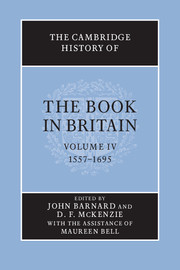Book contents
- Frontmatter
- Dedication
- Contents
- List of illustrations
- List of contributors
- Preface
- Acknowledgements
- Introduction
- RELIGION AND POLITICS
- ORAL TRADITIONS AND SCRIBAL CULTURE
- LITERATURE OF THE LEARNED
- LITERARY CANONS
- VERNACULAR TRADITIONS
- THE BUSINESS OF PRINT AND THE SPACE OF READING
- 26 Printing and publishing 1557–1700: constraints on the London book trades
- 27 The economic context
- 28 French paper in English books
- 29 The old English letter foundries
- 30 Bookbinding
- 31 Mise-en-page, illustration, expressive form
- BEYOND LONDON: PRODUCTION, DISTRIBUTION, RECEPTION
- DISRUPTION AND RESTRUCTURING: THE LATE SEVENTEENTH-CENTURY BOOK TRADE
- STATISTICAL APPENDICES
- Abbreviations
- Bibliography
- Index
- Plate Section
- References
29 - The old English letter foundries
from THE BUSINESS OF PRINT AND THE SPACE OF READING
- Frontmatter
- Dedication
- Contents
- List of illustrations
- List of contributors
- Preface
- Acknowledgements
- Introduction
- RELIGION AND POLITICS
- ORAL TRADITIONS AND SCRIBAL CULTURE
- LITERATURE OF THE LEARNED
- LITERARY CANONS
- VERNACULAR TRADITIONS
- THE BUSINESS OF PRINT AND THE SPACE OF READING
- 26 Printing and publishing 1557–1700: constraints on the London book trades
- 27 The economic context
- 28 French paper in English books
- 29 The old English letter foundries
- 30 Bookbinding
- 31 Mise-en-page, illustration, expressive form
- BEYOND LONDON: PRODUCTION, DISTRIBUTION, RECEPTION
- DISRUPTION AND RESTRUCTURING: THE LATE SEVENTEENTH-CENTURY BOOK TRADE
- STATISTICAL APPENDICES
- Abbreviations
- Bibliography
- Index
- Plate Section
- References
Summary
I have been with all the Letter-founders in Amsterdam, and if I would have given *** for matrices could not persuade any of ’em but the last I went to, to part with any. so far from it that it was with much ado I could get them to let me see their business. the Dutch Letter-founders are the most sly and jealous people that ever I saw in my life. However this last man (being as I perceived by the strong perfume of Geneva waters a most profound sot) offers to sell me all his house for about *** I mean the matrices: for the punchions with them he will not sell for any money. but there being about as much as he would have *** for, Hebr. and other Oriental languages, such as Syrian Samaritan and Russian characters, I would not consent to buy ’em. but the rest consisting of about 17 sets of Rom. and Ital. capitals and small letters, and about 5 sets of capital letters only, and 3 sets of Greek, besides a set or two of Black with other appurtenances, these I design to buy. he is not very fond of selling them because it will be a great while before he can furnish himself again. however I believe I shall have ’em for less than *** a matrice, which as he says is cheaper than ever they were his; but having most of the punches he can sink ’em again and so set himself to rights with little trouble and less charge.
Thomas James, son of the Reverend John James, vicar of Basingstoke, after serving his apprenticeship with Robert Andrews, set up on his own in 1710. For that purpose, he went to Holland to buy equipment, whence he wrote letters to his brother, of which this, dated from Rotterdam, 22 June 1710, is the first: ‘the account of his expedition is entertaining’, wrote Rowe Mores, who preserved and published the letters, in his characteristic under-capitalized style. So it is, but in this passage he also touches on some of the perennial problems that faced typefounders and their customers in Britain from the outset. In considering these it is difficult to avoid the assumption, often made by bibliographers anxious to attribute unsigned work to an identifiable printer, that types were made as well as used by printers.
- Type
- Chapter
- Information
- The Cambridge History of the Book in Britain , pp. 602 - 619Publisher: Cambridge University PressPrint publication year: 2002
References
- 2
- Cited by



